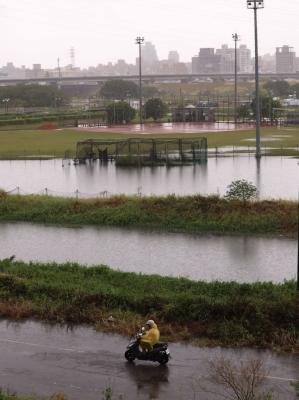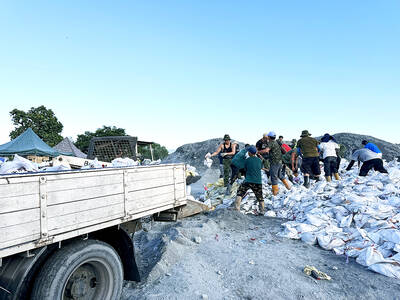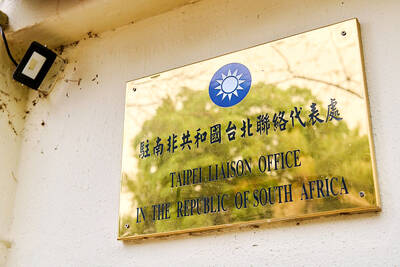Only 587 Chinese free independent travelers (FIT) have visited Taiwan since the program was launched one month ago, the National Immigration Agency said.
The figure was seen as a gloomy forecast for the FIT program, which allows up to 500 Chinese per day to visit without having to be part of a tour group, or be chaperoned by a tour guide.
However, Mainland Affairs Council Deputy Minister Liu Te-shun (劉德勳) said the apparent lack of interest in the program only showed that more time was needed for both sides to become familiar with the new system.
“When travel exchanges of tour groups took effect in 2008, the situation was as bad,” he said. “Look at what we have achieved now.”
The Tourism Bureau said more than 3 million Chinese have visited Taiwan since the government opened the door to Chinese tour groups three years ago, bringing in NT$195.8 billion (US$6.57 billion).
Liu said seasonal factors should also be taken into consideration because Chinese students, seen as the biggest base for the program, are preparing for their exam season.
Tourism Bureau Deputy Director-General David Hsieh (謝謂君) said the bureau had approved about 1,000 applications from Chinese FITs.
He said he expects the program to be in full swing once Taiwan establishes a good reputation among individual Chinese tourists.
Travel Agent Association chairman Yao Ta-kuang (姚大光) said he was satisfied with the tourist traffic so far.
“The program doesn’t operate like a tap,” Yao said. “Give it a little time and we will see the daily cap hit its limit.”
Not everyone in the association agrees.
“We didn’t expect the quota to be met right away, but we are shocked that so few solo tourists have come so far,” said Roger Hsu (許高慶), secretary-general of the Travel Agent Association.
Hsu said travel agencies were probably not enthusiastic about promoting individual tourism, considered high-risk and low-profit, because they could be suspended if anyone goes missing.
ADDITIONAL REPORTING BY AFP

Taipei, New Taipei City, Keelung and Taoyuan would issue a decision at 8pm on whether to cancel work and school tomorrow due to forecasted heavy rain, Keelung Mayor Hsieh Kuo-liang (謝國樑) said today. Hsieh told reporters that absent some pressing reason, the four northern cities would announce the decision jointly at 8pm. Keelung is expected to receive between 300mm and 490mm of rain in the period from 2pm today through 2pm tomorrow, Central Weather Administration data showed. Keelung City Government regulations stipulate that school and work can be canceled if rain totals in mountainous or low-elevation areas are forecast to exceed 350mm in

The Central Emergency Operations Center (CEOC) has made a three-phased compulsory evacuation plan for Hualien County’s Mataian River (馬太鞍溪) disaster zone ahead of the potential formation of a typhoon. The plan includes mandatory vertical evacuation using air-raid-style alarms if needed, CEOC chief coordinator Chi Lien-cheng (季連成) told a news conference in the county yesterday. Volunteers would be prohibited from entering the disaster area starting tomorrow, the retired general said. The first phase would be relocating vulnerable residents, including elderly people, disabled people, pregnant women and dialysis patients, in shelters and hospitals, he said. The second phase would be mandatory evacuation of residents living in

EVA Airways president Sun Chia-ming (孫嘉明) and other senior executives yesterday bowed in apology over the death of a flight attendant, saying the company has begun improving its health-reporting, review and work coordination mechanisms. “We promise to handle this matter with the utmost responsibility to ensure safer and healthier working conditions for all EVA Air employees,” Sun said. The flight attendant, a woman surnamed Sun (孫), died on Friday last week of undisclosed causes shortly after returning from a work assignment in Milan, Italy, the airline said. Chinese-language media reported that the woman fell ill working on a Taipei-to-Milan flight on Sept. 22

COUNTERMEASURE: Taiwan was to implement controls for 47 tech products bound for South Africa after the latter downgraded and renamed Taipei’s ‘de facto’ offices The Ministry of Foreign Affairs is still reviewing a new agreement proposed by the South African government last month to regulate the status of reciprocal representative offices, Minister of Foreign Affairs Lin Chia-lung (林佳龍) said yesterday. Asked about the latest developments in a year-long controversy over Taiwan’s de facto representative office in South Africa, Lin during a legislative session said that the ministry was consulting with legal experts on the proposed new agreement. While the new proposal offers Taiwan greater flexibility, the ministry does not find it acceptable, Lin said without elaborating. The ministry is still open to resuming retaliatory measures against South